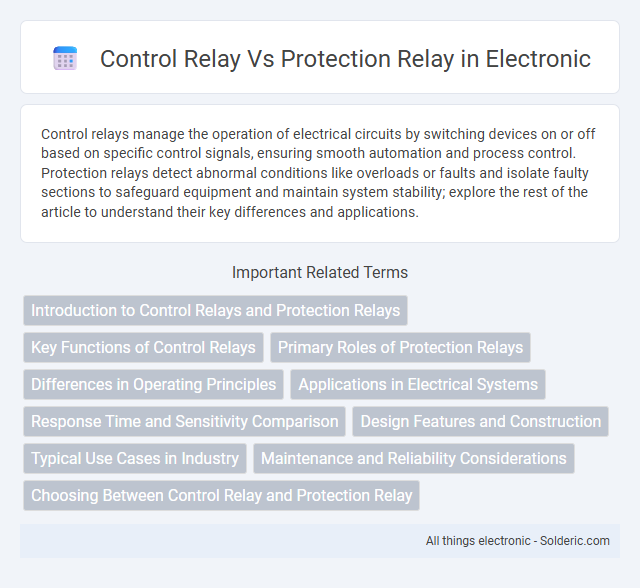Control relays manage the operation of electrical circuits by switching devices on or off based on specific control signals, ensuring smooth automation and process control. Protection relays detect abnormal conditions like overloads or faults and isolate faulty sections to safeguard equipment and maintain system stability; explore the rest of the article to understand their key differences and applications.
Comparison Table
| Feature | Control Relay | Protection Relay |
|---|---|---|
| Primary Function | Controls electrical circuits by opening/closing contacts | Protects electrical systems by detecting faults and triggering circuit breakers |
| Purpose | Operational control of devices like motors and lights | Safety and fault isolation in power systems |
| Operation | Switches circuits based on control signals | Monitors parameters (current, voltage) and trips when abnormal |
| Sensitivity | Low to moderate | High sensitivity to faults |
| Response Time | Relatively slower | Fast to immediately isolate faults |
| Examples | Electromechanical relays, solid-state relays | Overcurrent relays, differential relays, distance relays |
| Application | Automation, device control in electrical panels | Power system protection in substations and industrial plants |
| Complexity | Simple operation | Complex algorithms and logic involved |
Introduction to Control Relays and Protection Relays
Control relays and protection relays serve distinct functions in electrical systems, where control relays manage operational circuits by opening or closing contacts to start or stop devices, while protection relays detect faults and initiate corrective measures to prevent damage. Control relays are typically used for automation and control tasks, responding to control signals to ensure proper machine operation. Protection relays are essential for system safety, continuously monitoring electrical parameters such as current, voltage, and frequency to trigger circuit breakers during abnormal conditions.
Key Functions of Control Relays
Control relays primarily manage the operation of electrical circuits by opening or closing contacts to control devices such as motors, lights, and alarms based on input signals. They provide essential functions like switching, isolation, and logic operations within automation and control systems. Your electrical design benefits from the precise and reliable coordination that control relays offer for efficient circuit management.
Primary Roles of Protection Relays
Protection relays primarily monitor electrical circuits to detect faults such as short circuits, overloads, and abnormal voltages, triggering circuit breakers to isolate affected sections and prevent equipment damage. Control relays, in contrast, manage routine operations like switching and sequencing without fault detection capabilities. Your electrical system's safety heavily depends on the precise and rapid response of protection relays to maintain system stability and prevent catastrophic failures.
Differences in Operating Principles
Control relays operate based on simple electromagnetic principles to open or close contacts in low-power control circuits, primarily focusing on switching and automation tasks. Protection relays use complex sensing technologies, such as current, voltage, and frequency measurements, to detect abnormal conditions and initiate circuit breaker trips for system safety. The fundamental difference lies in control relays managing normal operations, while protection relays monitor and respond to faults to prevent equipment damage and ensure electrical system stability.
Applications in Electrical Systems
Control relays are primarily used in automation circuits to manage the operation of electrical equipment by opening or closing contacts based on control signals, ensuring efficient system control. Protection relays detect electrical faults, such as overloads or short circuits, and initiate disconnection of power to safeguard your electrical systems from damage. Both relays play crucial roles; control relays optimize operational processes, while protection relays maintain system safety and reliability.
Response Time and Sensitivity Comparison
Control relays typically have faster response times, often in the range of milliseconds, designed for quick switching and operational commands. Protection relays prioritize sensitivity to detect faults precisely, reacting to abnormal conditions such as overcurrent or short circuits, but their response speed may vary depending on the protection scheme. Your system's safety and efficiency depend on selecting the appropriate relay type that balances rapid response with accurate fault detection.
Design Features and Construction
Control relays typically feature simple electromagnetic coils designed for switching operations with minimal delay, emphasizing compact size and durability for routine control circuits. Protection relays incorporate advanced sensing elements and solid-state technology, ensuring rapid fault detection and isolation to safeguard electrical systems from damage. The construction of protection relays often includes multiple monitoring functions and robust insulation to withstand high fault currents and harsh environmental conditions.
Typical Use Cases in Industry
Control relays are primarily used in industrial automation to manage the operation of machinery, such as starting and stopping motors, switching lighting circuits, and cycling conveyor belts. Protection relays, on the other hand, safeguard electrical power systems by detecting faults like overloads, short circuits, and abnormal voltage conditions to trigger circuit breakers and prevent equipment damage. Industries such as manufacturing, power generation, and oil and gas rely heavily on control relays for process automation and protection relays for maintaining system safety and reliability.
Maintenance and Reliability Considerations
Maintenance of control relays involves regular testing and inspection to ensure operational accuracy, whereas protection relays require more rigorous diagnostics due to their critical role in preventing electrical faults. Reliability in protection relays is paramount, often featuring self-monitoring and fail-safe mechanisms to guarantee system safety, while control relays prioritize consistency in switching functions. Your choice between the two should consider the balance between maintenance complexity and the need for dependable fault detection to optimize system performance.
Choosing Between Control Relay and Protection Relay
Choosing between a control relay and a protection relay depends on your system's specific needs; control relays primarily manage switching operations and automation sequences while protection relays are designed to detect faults and initiate system isolation to prevent damage. Protection relays use precise sensing elements and algorithms to identify conditions like overcurrent, voltage abnormalities, or frequency deviations, ensuring equipment safety and system reliability. Control relays offer flexibility for controlling loads and logic, whereas protection relays focus on rapid, reliable fault detection for safeguarding electrical networks.
Control relay vs protection relay Infographic

 solderic.com
solderic.com